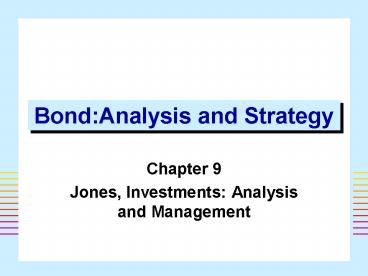Bond:Analysis and Strategy
1 / 19
Title:
Bond:Analysis and Strategy
Description:
Explanations of the shape of the yield curve and why it changes shape over time. 8 ... View bonds as source of capital gains arising from changes in interest rates ... –
Number of Views:59
Avg rating:3.0/5.0
Title: Bond:Analysis and Strategy
1
BondAnalysis and Strategy
- Chapter 9
- Jones, Investments Analysis and Management
1
2
Why Buy Bonds?
- Attractive to investors seeking steady income and
aggressive investors seeking capital gains - Promised yield to maturity is known at the time
of purchase - Can eliminate risk that a rise in rates decreases
bond price by holding to maturity
2
3
The Case Against Buying Bonds
- Dont hold bonds unless investing strictly for
income - Capital appreciation negative
- Alternative a combination of cash investments
and stocks - Investors should consider whether they could
build better portfolios that do not include bonds
3
4
Buying Foreign Bonds
- Why?
- Foreign bonds may offer higher returns at a point
in time than alternative domestic bonds - Diversification
- Can be costly and time-consuming
- Illiquid markets
- Transaction costs and exchange rate risk
4
5
Understanding the Bond Market
- Benefits from a weak economy
- Interest rates decline and bond prices increase
- Important relationship is between bond yields and
inflation rates - Investors react to expectations of future
inflation rather than current actual inflation
5
6
The Term Structure of Interest Rates
- Term structure of interest rates
- Relationship between time to maturity and yields
- Yield curves
- Graphical depiction of the relationship between
yields and time for bonds that are identical
except for maturity - Default risk held constant
6
7
Term Structure of Interest Rates
- Upward-sloping yield curve
- typical, interest rates rise with maturity
- Downward-sloping (or inverted) yield curves
- Unusual, predictor of recession?
- Term structure theories
- Explanations of the shape of the yield curve and
why it changes shape over time
7
8
Pure Expectations Theory
- Long-term rates are an average of current
short-term rates and those expected to prevail
over the long-term period - Average is geometric rather than arithmetic
- If expectations otherwise, the shape of the yield
curve will change - Forward rates are rates that are expected to
prevail in the future
8
9
Liquidity Preference Theory
- Rates reflect current and expected short rates,
plus liquidity risk premiums - Liquidity premium to induce long term lending
- Implies long-term bonds should offer higher
yields - Interest rate expectations are uncertain
9
10
Preferred Habitat Theory
- Investors have preferred maturities
- Borrowers and lenders can be induced to shift
maturities with appropriate risk premium
compensation - Shape of yield curve reflects relative supplies
of securities in each sector - Most market observers are not firm believers in
any one theory
10
11
Risk Structure of Rates
- Yield spreads
- Relationship between yields and the particular
features on various bonds - Yield spreads are a result of
- Differences in quality, coupon rates,
callability, marketability, tax treatments,
issuing country
11
12
Passive Bond Strategies
- Investors do not actively seek out trading
possibilities in an attempt to outperform the
market - Bond prices fairly determined
- Risk is the portfolio variable to control
- Investors do assess default and call risk
- Diversify bond holdings to match preferences
12
13
Passive Bond Strategies
- Buy and hold
- Choose most promising bonds that meet the
investors requirements - No attempt to trade in search of higher returns
- Indexing
- Attempt to match performance of a well known bond
index - Indexed bond mutual funds
13
14
Immunization
- Used to protect a bond portfolio against interest
rate risk - Price risk and reinvestment risk cancel
- Price risk results from relationship between bond
prices and rates - Reinvestment risk results from uncertainty about
the reinvestment rate for future coupon income
14
15
Immunization
- Risk components move in opposite directions
- Favorable results on one side can be used to
offset unfavorable results on the other - Portfolio immunized if the duration of the
portfolio is equal to investment horizon - Like owning zero-coupon bond
15
16
Active Bond Strategies
- Requires a forecast of changes in interest rates
- Lengthen (shorten) maturity of bond portfolio
when interest rates are expected to decline
(rise) - Horizon analysis
- Projection of bond performance over investment
horizon given reinvestment rates and future yield
assumptions
16
17
Active Bond Strategies
- Identify mispricing among bonds then swap
- Substitution swap, yield pickup swap, rate
anticipation swap, sector swap - Interest rate swaps
- Exchange a series of cash flows
- Convert from fixed- to floating-rate
- Primarily used to hedge interest rate risk
17
18
Building a Fixed-Income Portfolio
- If conservative investor
- View bonds as fixed-income securities that will
pay them a steady stream of income with little
risk - Buy and hold Treasury securities
- Conservative investor should consider
- Maturity, reinvestment risk, rate expectations,
differences in coupons, indirect investing
18
19
Building a Fixed Income Portfolio
- If aggressive investor
- View bonds as source of capital gains arising
from changes in interest rates - Treasury bonds can be bought on margin to further
magnify gains (or losses) - Seek the highest total return
- International bonds
- Direct or indirect investment
19






























![READ [PDF] Bond Markets, Analysis, and Strategies, tenth edition 10th Edition](https://s3.amazonaws.com/images.powershow.com/10099569.th0.jpg?_=20240815038)
